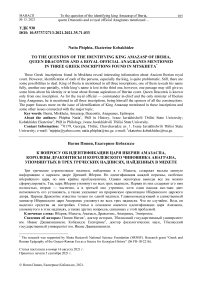To the question of the identifying king Amazasp of Iberia, queen Dracontis and a royal official Anagranes mentioned in three Greek inscriptions found in Mtskheta
Автор: Phiphia Natia, Kobakhidze Ekaterine
Журнал: Материалы по археологии и истории античного и средневекового Причерноморья @maiask
Рубрика: Эпиграфика
Статья в выпуске: 13, 2021 года.
Бесплатный доступ
Three Greek inscriptions found in Mtskheta reveal interesting information about Ancient Iberian royal court. However, identification of each of the persons, especially the king, is quite problematic. Still, there are some possibilities to deal. King of Iberia is mentioned in all three inscriptions, one of them reveals his name fully, another one partially, while king’s name is lost in the third one, however, one passage may still give us some hints about his identity or at least about Roman aspirations of Iberian court. Queen Dracontis is known only from one inscription. As for the royal official - commander in-chief and the only minister of Iberian king Anagranes, he is mentioned in all three inscriptions, being himself the sponsor of all the constructions. The paper focuses more on the issue of identification of King Amazasp mentioned in these inscriptions and some other issues connected with the major topic.
Iberia, mtskheta, amazasp, dracontis, anagranes, epitropos
Короткий адрес: https://sciup.org/14123594
IDR: 14123594
Список литературы To the question of the identifying king Amazasp of Iberia, queen Dracontis and a royal official Anagranes mentioned in three Greek inscriptions found in Mtskheta
- Abuladze, I. (ed.) 1963. Moktsevai Kartlisai, Shatberdis krebuli. Dzveli kartuli agiograpiuli literaturis dzeglebi (Conversion of Kartli, Shatberdi manuscript. Monuments of Ancient Georgian Hagiographie Literature). Vol. I. 5th — 10th cc. Tbilisi: Academy of Sciences of Georgia Press (in Georgian).
- Bournoutian, G. A. 2002. A Concise History of the Armenian People: from Ancient Times to the Present. Costa Mesa: Mazda Publishers.
- Braund, D. 2002. Anagranes the TPOOEYE: the court of Caucasian Iberia in the second—third centuries AD. In: Kacharava D., Faudot, M., Geny, É. (eds.). Autour de la mer Noire. Hommage de Otar Lordkipanidzé. Besançon: Institut des Sciences et Techniques de l'Antiquité, 23—34 (ISTA 862).
- Dundua, T. 2017. Sakartvelos udzvelesi da dzveli istoriis narkvevebi (Essays on Old and Ancient History of Georgia). Tbilisi: Meridiani (in Georgian).
- Kaukhchihvili, S. (ed.) 1955. Kartlis tskhovreba ("Life of Kartli"). Vol. I. Tbilisi: Sakhelgami (in Georgian).
- Kaukhchishvili, T. 2000. Sakartvelos berdznuli tsartserebis korpusi (Corpus of Greek Inscriptions in Georgia). Vol. II. Eastern Georgia. Tbilisi: Logosi (in Georgian).
- Kaukhchishvili, T. 1998. Akhali berdnuli tsartsera armtsikhe-baginetidan (New Greek Inscription Discovered in Armaztsikhe-Bagineti) II(8). Essays. Vol. IV (in Georgian).
- Meliqisvili, G. (ed.). 1970. Sakartvelos istoriis narkvevebi (Essays in Georgian History). Vol. I. Gruziya s drevneyshikh vremen do 4 v. n.e. (Georgia from ancient times to the 4th century CE). Tbilisi: Sabchota Sakartvelo (in Georgian).
- Mgaloblishvili, T. Rapp, S.H. 2010. Manichaeism in Late Antique Georgia? In: Jacob Albert van den Berg, J.,A., Kotzé A., Nicklas, T., Scopello, M. (eds.). Search of Truth. Augustine, Manichaeism and other Gnosticism. Leiden: Brill, 263—290 (Nag Hammadi and Manichaean Studies 74).
- Phiphia, N. 2019. King Pacorus, Bakur of Lazi. Materialy po arkheologii i istorii antichnogo i srednevekovogo Prichernomor'ya (Proceedings in Archaeology and History of Ancient and Medieval Black Sea Region) 11, 484—490.
- Tsereteli, G. Iveria akh. ts. mesame saukunis tsyaroebhi (Iveria in the 3rd century CE. Iranian Sources). On manuscript rights. Unpublished manuscript is kept on personal archive of G. Tsereteli (in Georgian).
- Tsereteli, G.V. 1941. Armazskaya bilingva. Dvuyazychnaya nadpis', naydennaya pri arkheologicheskikh raskopkakh v Mtskheta-Armazi (Armazi Bilingual Inscription found during Archaeological Excavations of Mtskheta). Tbilisi: AN Gruz. SSR (in Russian).


